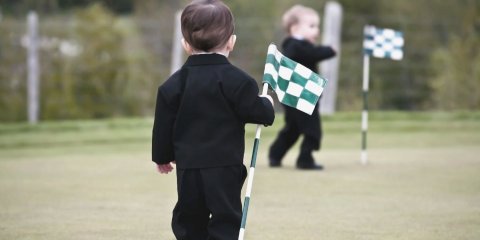Key Points
- Toddlers need at least 3 hours of physical activity each day for healthy development
- Unstructured active play can help them develop foundational skills like running and jumping
- It’s best not to enrol in sports for toddlers until they are developmentally ready
- Multi-sport programming could be the best type of organised sport for toddlers
With increasingly sedentary lifestyles, it’s important to encourage our kids to take part in as much physical activity as possible. It’s critical for their ongoing mental and physical wellbeing, but also to develop essential motor skills.
So, what are the best types of physical activity? Should you be aiming for more unstructured play, or enrolling in organised sports for toddlers?
In this article, we explain:
- Barriers to physical activity for our kids
- How much physical activity our toddlers need each day
- Why organised sports are unnecessary if toddlers get enough unstructured active play
- Parental motivations and what sports for toddlers are on offer
- What is sports readiness?
- Benefits of multi-sport programming
Barriers to physical activity
There are many things that can stand in the way of our children getting the level of physical activity they need.
These barriers include:
- Safety concerns for playing out and about in our neighbourhoods
- Our own work demands, which can limit time available for physical activity
- Easy accessibility to television and gaming consoles
- Perceived costs of organised sports
Are any of these barriers relevant to your family?
It helps to reflect on how these may be interfering, so you can navigate around them and provide your toddler with the levels of physical activity they require.
How much physical activity do toddlers need?
From ages 1-5, it’s recommended that children have at least three hours of physical activity each day . And throughout each day, toddlers should not be sedentary for more than 60 minutes at once (this does not include naps and night-time sleeping).
It does not mean that toddlers need three hours of vigorous activity all in one go. But, they should take part in activities that are varied and experienced in short bursts (from 5-15 minutes for example).

According to the World Health Organisation (WHO), a staggering number of children worldwide are overweight - more than 42 million! Toddlers are at risk of becoming overweight without enough physical activity, and too much time in front of devices.
And early sedentary behaviour has “been linked to the surge of overweight children, adolescents and adults” which is difficult to reverse.
That is why prevention is advocated - we should ideally foster healthy habits in our children from infancy.
Physical activity doesn’t just help toddlers maintain a healthy weight though. A systematic review investigated the link between physical activity and a number of health indicators in 0-4 year olds. It found that higher levels of activity are associated with:
- “Bone and skeletal health
- Motor skill development
- Psychosocial health
- Cognitive development
- Aspects of cardiometabolic health”
It’s also important to point out that increased levels of physical activity were not associated with any risks .
Let’s now look specifically at one option of physical activity for toddlers: active play.
Unstructured active play
It’s easy to get caught up in the mindset of trying to be the perfect parent, and believe that you should chauffeur your kids around from one activity to the next.

But, the truth is that your toddler is growing rapidly. The aim at this young age, is not for them to become competent or skilled at a particular sport, but “ to develop skills that are building blocks for more complex movement tasks .”
These foundational skills include:
- Tumbling
- Running
- Throwing
- Catching
- Jumping
- Swimming
You’ve probably just realised that these types of physical activity don’t actually require your toddler to attend organised sports or instructional lessons. Instead, these skills can be learned through unstructured active play, where your toddler gets the opportunity to “ explore, experiment and copy others .”
For example, you can give your toddler the opportunity to:
- Ride a tricycle or bike
- Climb playground equipment
- Play hopscotch
- Skip
- Throw and catch a ball
- Swim at the local pool (or at home if you have a pool)
These activities can be done as a family (whether your toddler has siblings or not) and also with other children of a similar age. That way, they can see how others do things in different ways and try it all out for themselves.
Sometimes it’s the simplest opportunities we provide our kids that offer the most value.
Now, let’s turn to organised sports, and take a peek at why parents may go down the path of choosing sports for toddlers.
Parental motivations
Some popular organised sports programs for toddlers include:
- Learn to play soccer programs (eg. Soccajoeys)
- Learn to play basketball programs
- Football techniques programs
- Gymnastics programs like kindergym
- Dance classes
- Multi-sport programs
A study of 3-5 year olds examined why parents enrol their children in sports . It is assumed that this study can be extrapolated (at least in part) to explain why some toddlers aged 1-3 are also enrolled in sport.
The study uncovered the following parental motivations :
- If a child has shown a particular aptitude or interest for a certain sport.
- Some parents enrolled in multi-sport programming first. The intention was to introduce children to a variety of ball-sports and then choose one to continue into.
- Some wanted their children to follow in their footsteps, thereby enrolling toddlers in the same sports they played.
- But others wanted their kids to have opportunities they never had, and so enrolled in sports different to their own.
- Finally, some admitted it was easier to enrol younger children in sports that older siblings also played, due to already owning equipment and for the convenience of attending the same facilities.
You can see that none of these motivations really focus on whether their child was ready for sport.
So, what is sports readiness anyway?
Sports readiness
According to raisingchildren.net.au, the ideal time to enrol children in organised sport is when they are ready . However, when exactly this is, depends on the individual child and indeed, may not be during the toddler years at all.
It is clear that this is an emerging field and more research is needed to draw a conclusion on whether toddlers should do organised sports . A few things have come to light however.
According to an article published by the Mayo Clinic, toddlers (and even children up to age 5), are simply too young for most organised sports . They have a limited attention span, and their balance is still developing. Additionally, their “ ability to track moving objects is not fully mature ”.
And it’s not just about the physical limitations, but how things like self-confidence develop only when you go at a pace appropriate to their development . An activity that proves too challenging for their stage of development doesn’t bring enjoyment - only frustration.
Swimming lessons are extremely popular, right from infancy. By toddlerhood, some are even attending one-on-one lessons.
Many parents choose to enrol their babies and toddlers in these aquatic programs because they have been led to believe that they can learn water safety skills at this young age. And this is important after all, given how much swimming is part of our Australian lifestyle.
But, according to the American Academy of Pediatrics, data does not exist to prove if toddler swimming programs decrease the chance of drowning .
They further claim that “infant and toddler swimming programs are unable to ensure that children will understand water hazards, use appropriate avoidance strategies, or attain program safety goals.” “Therefore, having children begin swimming lessons at an earlier age does not translate to a more rapid mastery of aquatic skills or a higher level of swimming proficiency.”
So, even if your toddler seems to be doing well in these lessons, it does not mean they are developmentally ready for being safe in the water.
Perhaps these swimming programs are better thought of as a way to get used to being in pools, and to build vital motor skills.
Benefits of multi-sport programming
If you choose to enrol your child in organised sports, one that offers the opportunity to try out multiple sports could be your best option. In fact, research has indicated there are benefits of sampling multiple sports , rather than focusing on one. These include “more well rounded motor skill development and long-term sport involvement”.
It’s important that this isn’t intended as a way to decide on an early specialisation, however, because early specialisation in one sport can limit the enjoyment they may otherwise receive from experiencing multiple sports.
The long-term effects of early specialisation are even more alarming, including burnout, mental stress and risk of overuse injury .
So, before you go down the path of organised sports for toddlers, please ask yourself these questions:
- What are your motivations for enrolling them?
- Are they developmentally ready?
- Will they learn the foundational skills they need for adequate motor development?
- Are they interested in participating in the sport?
- And finally, could you provide them with enough unstructured active play each day, without attending organised sports?

